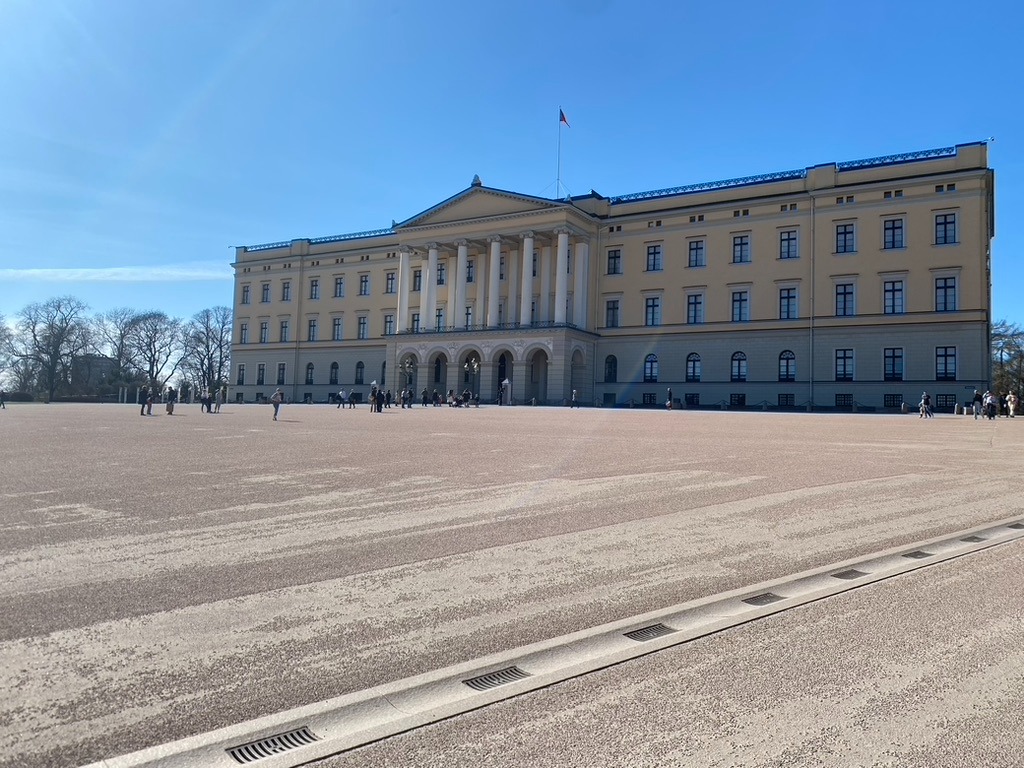

Oslo 🇳🇴
Published by Daron on
Share this post
You can easily share this post on social media by clicking the "Copy URL" button or copy and pasting the URL from the box below.
Image of the Royal Palace. There are two guards but if you really wanted to, I bet you could knock on the front door with a little help!
After saying our goodbyes to the gray skies o'er Scotland, we flew across the North Sea in search of sunshine and pleasant weather. A short 90 minute flight dropped us in one of the northernmost territories on the European continent, Norway!
I've always been a bit fascinated with the Nordic countries, and while seeing all of them isn't in the cards for this trip, I was determined to at least see a few.
Our flight was uneventful, although I was pleasantly surprised by the free beer on offer for the in-flight refreshment! We exited the plane via the stairs again and crammed into a bus, then ferried a short way to the terminal. A short walk led us to customs. Lucky for us, we were the last ones on the bus and so the first to step off. Only a few foreigners were ahead of us in the ever-growing line of people needing a passport stamp for an impromptu visa. Our conversation with the customs agent lasted all of 60 seconds before we were waived onward to the baggage claim area. After retrieving our luggage, we purchased express train tickets to the Oslo city center and departed the airport.
Citybox Oslo (A short review)
Our hotel accommodations were modest, as usual. While we did save a lot of money for this trip, I'm a bit of a natural penny-pincher in a lot of areas. We had three nights booked at Citybox Oslo (this was later easily extended to four). The name I think is derived from the shape of the rooms. Our room was a cozy 110~ sqft. (including the bathroom)! By the time you factor in the double bed, there was just enough space to squeeze on either side and into the plush-topped foam mattress. Outside the room however, was a different story.
The hotel is really a solo/couple traveler's dream. Generous shared spaces abound on the ground floor, with plenty of seating areas and nooks to be alone and work or relax. A large communal kitchen hosted a fridge, 2 microwaves, and a coffee machine, with vending and laundry on site for a reasonable additional fee.
There are also two restaurants connected directly to the hotel, though they operate on their own schedules. One of the offerings will even deliver to your room. Unfortunately for us, since our visit was over the Easter weekend holiday, many things were closed all over the city, or had strange hours that didn't line up with our other plans.
If you're a digital nomad and find yourself visiting one of the five cities where Citybox operates, I highly suggest trying it out!
Oslo
Our first stop outside of the UK, I was eager to experience city life from a more modern time. The first thing I noticed was the generous use of space in general. The streets and sidewalks were wider than the UK. The cars used by locals also leaned more compact in size, sitting comfortably in the middle of the road. One way streets in the grid of downtown meant more space for everyone. The buildings here were also tall and felt solid and grounded via appearance alone. They were also colorful! Dark blues, greens, yellows, and red were just as common as polished stone or concrete.
The residential housing also followed this same pattern. Most homes tended to be more than one story, and likely had basements as well. Large windows were not uncommon, though I was surprised to see how many homes were of "normal" styles compared to the ultra modern depictions of Scandinavia in popular media.
Parking in the city seemed a bit on the sparse side, but given the robust public transportation infrastructure, I'd imagine most people who live in the city don't actually own a car. A slight detour, Norway drives on the right, so I was much more confident crossing the road knowing I was predicting the movement of traffic accurately! There was a constant flow of red busses zipping across the city, sky blue trams acted as more efficient transportation for heavily trafficked routes, and a half dozen metro lines connected the outskirts to the city center.
One commonality that I was starting to pick up on, is how each of these cities and towns is fundamentally built around common infrastructure. From the aerial view of your favorite online maps website, you can see the city built around the central train station, a dozen lines converging into one point and spreading out like the tentacles of a giant sea squid. Most of these cities had hundreds of thousands of inhabitants before the first Model T rolled off the production line. They needed a robust way to move people, goods, and services and trains filled that role for a hundred years before the automobile.
The future of transportation in America
This is another tangent, but I truly believe that many American cities would be vastly benefited by the adoption of a widespread passenger rail network and robust public transportation. Imagine how productive we already are without this infrastructure. If major cities like LA, Atlanta, Houston and Dallas could really go all-in on trains, they would cement their place as powerhouses of American culture, production, and economic prosperity. I would argue this is the main reason NYC has historically seen so much success, now to the point where it's becoming impossible to expand the infrastructure to keep up with the demand.
If these historically car-dependent cities can build robust train networks, it will allow workers to move away from the city center and into more cost effective housing developments. Business however, will remain in the city, in addition to tourism and leisure activities. No doubt, it would be very expensive, likely requiring eminent domain to acquire the land necessary, but we cannot keep building out super suburbia for the next 100 years. I would rather build 4 rail tracks instead of another 20 lane highway.
Moving to a world with fewer cars won't be easy, but with self-driving technology hurling at us full speed ahead, I have a feeling in 50 years, many people won't own a car anyway, as the economics of pay-per-mile end up cheaper for the vast majority of households. Not to mention the freedom it would provide to the disabled or elderly. With robust public transportation or cheap self-driving tech, these people become free to travel on their own time and their own terms. Pair this with the rise of online work from home opportunities (Me!); creating walkable communities will become more and more important as we lose the need to commute to the office.
Bringing it back
London, Berwick, Edinburgh, and now Oslo have shown me firsthand the power of the commons. How some public resources are so vital to the health, happiness, freedom, and economic prosperity of the citizenry. As I write this from a neighboring country, I can't wait to expound upon these ideas in later posts. None of the places I listed were especially bike friendly (though miles and miles ahead when compared to the USA), but I'm sure our future visits to Belgium and the Netherlands will prove just as eye opening as these first two weeks.
In my next post, I'll expound more on my experience in Oslo, but I'll leave this as the backdrop for the upcoming adventure!